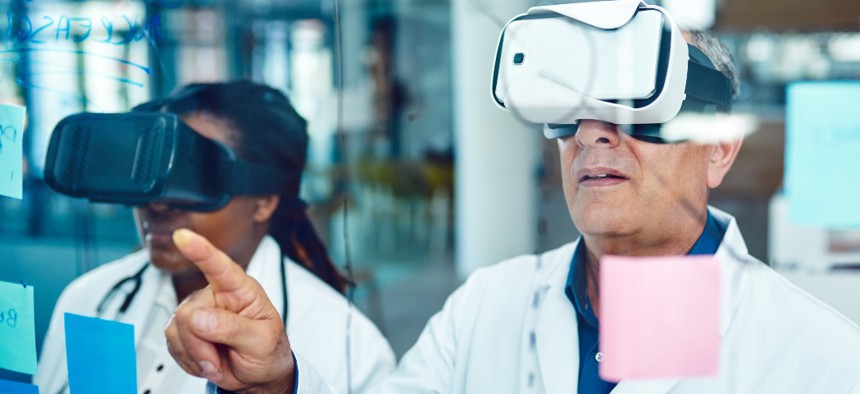VA Continues Healthcare Modernization With Simulated Employee Training

Charday Penn/Getty Images
Officials are seeking industry input for SIMPLE, a pending platform to help train VA employees virtually.
The Department of Veterans’ Affairs aims to angle its modernization efforts in a flexible direction with new virtual reality technology that can be scaled and utilized as a “one size fits all” solution to meet a variety of the department’s virtual health care needs.
Outlined in a request for information, officials at the VA’s Office of Healthcare Innovation and Learning hub are looking for help in designing a new platform specializing in virtual reality simulations that can be tailored to VA enterprise operations.
Dubbed the Simulation Platform for Learning and Education, or SIMPLE, the software will serve as “the binding tie” for the programs within the Veterans Health Administration to employ simulations as safe health care training for physicians.
“We need new tools to move beyond our brick and mortar to modernize our myriad simulation services remotely or by virtual means across the VA enterprise, and this will also help us deepen collaboration,” Brian Stevenson, the associate director for the VA’s emerging health care technology division, told Nextgov.
SIMPLE aims to work to seamlessly integrate different projects within the VA’s Simulation Learning, Evaluation, Assessment and Research Network, or SimLEARN. That branch of the agency is dedicated to promoting and improving best health care practices for physicians attending to veterans.
Due to both a desire to integrate emerging technologies into veteran healthcare and a need to tailor training around remote work, VA officials are looking to expand their digital offerings to continue its mission-driven projects.
“The hope is…to work in concert to improve retention of knowledge, provide a safe environment to experiment and practice without serious consequences, to motivate the employees to be active learners and not just passive participants, enable instantaneous feedback and become a force multiplier of discovery and innovation across the VA enterprise,” Stevenson said.
Some of the offices within the SimLEARN program who are anticipated to use SIMPLE include the Clinical Training and Engagement Offices, Learning Management and Stevenson’s Emerging Healthcare Technology Integration Office.
“We could all use simulation for different ways,” Stevenson said. “It's pretty exciting.”
He added that the technology is intended for federal employees, specifically health care providers and other full time staff. Another key feature of SIMPLE is intended availability on a bevy of devices and networks, to enable cohesive remote work, such as remotely practicing procedures on mannequins simultaneously.
“SIMPLE should be something that has the ability to absorb almost anything it will and that that is a tall order,” Stevenson said. “So that's why we see it as a long term venture that will continue to grow. And as devices become deprecated we need to off ramp those and on ramp new ones. So we expect this to be a very long journey.”
He also added that with SIMPLE, SimLEARN officials are seeking a vendor that can bring all desired elements together. Stevenson said the department intends to “stay nimble” and adapt to what vendors can deliver.
“To make live simulation work remotely, it needs quite a few more buttons, nuts and bolts than anything that we've seen, or would have gone after it already,” he stated. “So that's what we don't know. And that's what we're asking and trying to find out.”
SIMPLE follows the VA’s efforts to transform their digital operations to better care for veterans in remote areas amid the pandemic.
“The VA is going to great lengths to meet the VA provider community at the point of care at the point of need, where they are so that they have all the tools they need to practice and learn their profession better in the care of veterans,” Stevenson said. “So it's the safest way that we can enjoy new capability at zero harm.”






